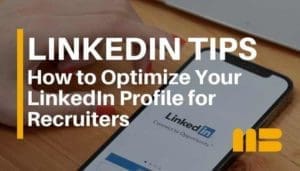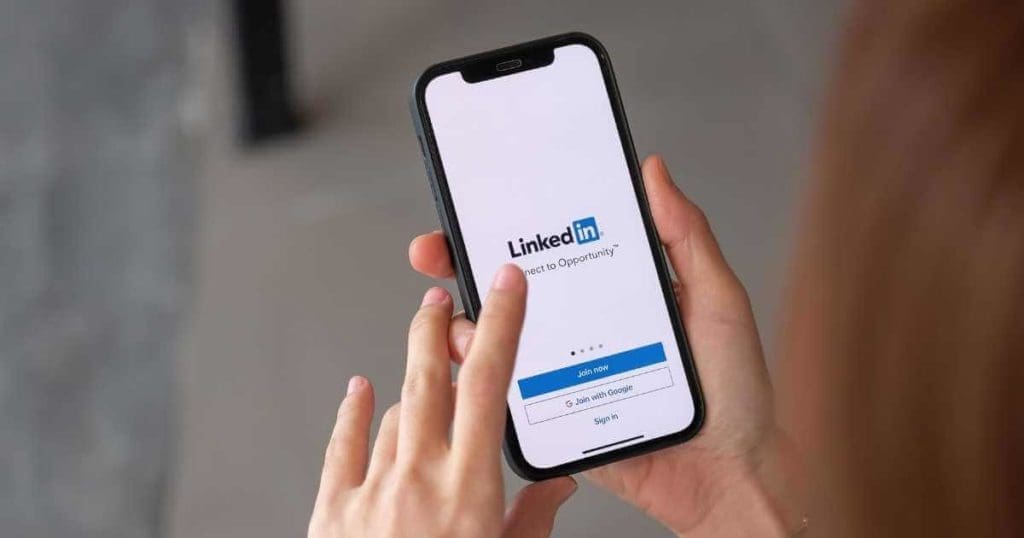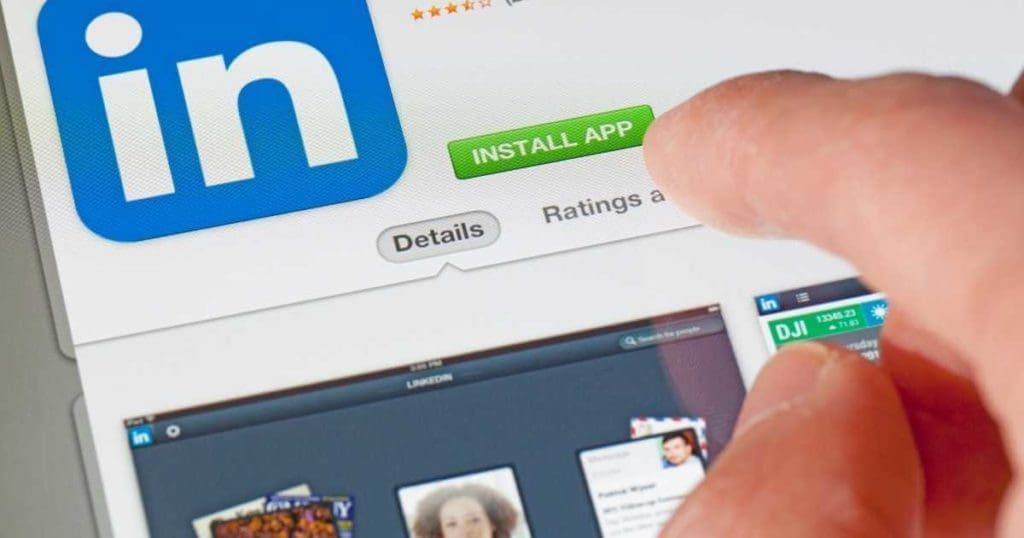Learning how to optimize your LinkedIn profile for recruiters is extremely important to find your next job. Candidates often ask us, “What is the best way to get noticed by recruiters on LinkedIn?” so we asked leading career counselors, HR professionals, LinkedIn writers, and resume writers for their advice.
The overwhelming response was to optimize your profile on LinkedIn, one of the premier social media platforms for business. Search engine optimization on a LinkedIn profile is when every part of your personal profile is filled out and shows HR managers or recruiters what you do, who you are, and what you are an expert in. This helps your profile rank higher in LinkedIn searches and builds trust among those who might want to connect or follow you.
The overall goal of LinkedIn optimization is that potential employers and recruiters find you in their search results. Just listing your current job title, current employer, and work history are not enough. Below are the best ways to optimize your LinkedIn profile for recruiters from the experts we connected with.
Top 10 Best Ways to Optimize Your LinkedIn Profile for Recruiters
1. Strategize Your Content
Be strategic with the content you share and post on LinkedIn.
As someone who has hired candidates in the past, this is something I often look at when searching through someone’s LinkedIn profile. It is essential to use your LinkedIn as a tool that can help an employer to get some details about who you are and what you are interested in.
This is why it can be beneficial to detail your profile to fit the type of job you are looking for. Posting content about real-world events you are interested in can help, as well as sharing posts from other similar companies to those you want to be a part of or learn more about.
This helps to give your LinkedIn character and makes it easier for possible employers to see your interests and how your skills match. It is all about quality over quantity when it comes to posting on LinkedIn, which is why being smart about what you post can really help you in the end.
Adam Moore is the founder of SocialPlus, a company that helps you accelerate growth on social media networks.
2. Reinforce Your Personal Brand
Use your LinkedIn profile to reinforce your personal brand and what you want to be known for in your career. Be selective and specific about what you choose to highlight, so it allows you to stand out to your desired audience.
About section: The About section is where you can provide a concise snapshot of your identity, skillset, work approach, and professional mission.
Featured section: When job hunting, make sure your Featured section is populated with items that reinforce the skills or accomplishments you feel are more relevant to the target employer. This section is one of the first visible sections of your profile that gives you an opportunity to create an all-important first impression of the value you create in your professional life.
headline: Ensure your headline image highlights the specific skillset and job title(s) you feel accurately represent your personal brand positioning.
Background image: In addition to including a current headshot, customize your LinkedIn background image with a photo that relates to your skills, organization, domain expertise, or professional mission.
Recommendations: The Recommendations section of your profile is a natural place to highlight your soft skills and transferrable skills. With any recommendation request, ensure you’re specifying the key areas of your approach you want others to highlight.
Joseph Liu is a career consultant and host of the Career Relaunch podcast.
3. Set Clear Goals
My number one tip for job seekers to optimize their LinkedIn profiles is to set clear goals. This is the first step in optimizing your account. You may need to sit down and think about how you want to represent yourself. That’s because you are a brand that needs to put its best image forward. As a result, you should alter your profile by checking what strategy allows you to reach your business goals.
Another tip to optimize your profile for employers is actively using the “Who’s Viewed Your Profile” metric from the dashboard. This feature allows you to see who has visited your page, which helps you to understand your target audience. In this case, talent acquisition heads or recruiters should be viewing your profile. So, use keywords in your description to attract them to your LinkedIn brand. The more relevant your keywords are in accordance with your goals, the greater your chances of landing a great job.
Irene McConnell is a career coach, hiring manager, and MD of Arielle Executive. She is also an official member of the Forbes Coaches Council.
4. Research Your Target Audience
Start by doing some research on what recruiters and hiring managers are looking for in a candidate. For instance, you can have a look at the profiles of other professionals in your niche to get an idea of important elements to include. Customize your profile based on your research findings. This will help you make sure that your profile is representative of what employers are looking for.
Secondly, focus on showing off your accomplishments, not just your job titles and work experience. It’s important to highlight what you’ve done rather than just what company you worked for or how long you worked there.
Arthur Worsley is the founder of The Art of Living, a website that helps top performers lead happier, more balanced lives. He is a former McKinsey Associate with an MA in Psychology from Oxford University.”
5. Clean Up Your Headshot
Use a professional-looking headshot as your profile photo and set its visibility to the public. This doesn’t mean you need to pay for headshots, but take a dedicated photo wearing professional clothing that shows only you in front of a relatively neutral background. Setting it to public ensures anyone who’s checking your profile will be able to find your profile and see it in full more easily.
Use keywords relevant to your search in your headline. If you’re not sure what these are, compare the titles of postings you feel are a good fit for your skills and look for the words and phrasing they use to describe the type of work you do. Obviously, it should still be a true description of your role, but for most jobs, there are several ways to describe them, and which you use can affect whether you stand out to both automated screening systems and hiring managers who are quickly reviewing candidates on LinkedIn.
Show your value as a candidate in the first 250-300 characters of your summary. This is the part that will show before the “See More,” so it’s where you need to hook someone into wanting to dig deeper. Identify which of your skills or experience makes you the most qualified for the job you want, then make sure that comes across early in your summary.
Michael Moran is the owner of Green Lion Search Group, a recruiting firm based in Austin, TX.
6. Use the Right Keywords
Use the right keywords: Keywords should reflect what you do. If you’re a web developer, use “web developer” as your keyword. If you’ve been working in the field for years, try using “expertise” instead of “experienced.”
Create a professional headline: A good headline can make or break your profile. Make sure that your headline reflects who you are and what you do. Try not to include too many words; keep it short and sweet.
Add relevant skills: You don’t want to list out everything you know how to do. Instead, focus on listing out the specific skills that are relevant to your industry and the job descriptions.
Leslie Radka is the founder and hiring manager of GreatPeopleSearch, a leading background check firm.
7. Maximize Your Introduction
As a professional career coach and certified professional resume writer (CPRW), my LinkedIn advice for clients always starts with the following: start by maximizing the top portion of the introduction of your LinkedIn profile.
This is what recruiters and hiring managers will see first when they view your profile.
Tip #1: Your headline should be keyword rich and reflect the job you or the industry you are targeting so that you’ll maximize your chances of a recruiter finding you.
For example, Digital Marketing Consultant – Market Research – Social Media Marketing
Tip #2: Next, I suggest checking the “open to” function (also located in the introduction section of your profile).
You can either click “open to work” if you’re job searching or “open to providing services” if you are a freelancer or have a private practice in your field and you want to attract clients.
Tip #3: The “about” section (directly underneath the introduction) is another prime location of your profile to add keywords that are related to your targeted job(s) and field.
If you need some inspiration, you can search job postings in your targeted field to get an idea of the skills and expertise employers are searching for.
In addition to keywords, you want to articulate your passion and value-add to your field. What makes you stand out in your profession? What do you love most about it? Unlike your resume, your profile should be written in the first person and reflect your personality.
Tip #4: In the “Experience” section of your profile, you want to also use the first person and give an overview of the scope of your role for each of your current and prior jobs. I encourage clients to not just repeat the information from their resumes. A recruiter wants to see a more personal aspect on their LinkedIn profile. It’s your chance to tell a more in-depth story about what you achieved in your positions and what made you stand out.
Lee Cristina Beaser received her MS in Career Counseling, worked in higher education for about ten years, is certified as a professional resume writer, and founded The Career Counter, where she helps moms with career reinvention. She is a Forbes Coaches Council Member as well as a regular contributor on Fairygodboss, where she writes articles that help job seekers successfully navigate a career change.
8. Leverage Keywords from Job Postings
If you’re a job seeker, start in the Jobs section of LinkedIn to review job listings and identify your ideal role. Mine those listings for repeated keywords and core competencies and incorporate them throughout your profile to add keyword density and increase your chances of getting noticed in an employer’s LinkedIn search.
This includes adding these terms to your Headline, as a list of expertise or specialties in your “About” section, as designated skills in your “Skills” section, and in the text of your “Experience” section.
There are a few hidden fields in your profile that you can use to optimize your profile, increase its visibility, and attract your dream job. Complete the “Open to finding a new job” tool (the blue button under your name that only you can see).
Follow all of the companies that you’re targeting to indicate your interest (recruiters can see who you follow) and stay up-to-date on company news. Change your “industry”—a field in your “Intro” that isn’t visible except to you and recruiters—corresponds with your target employer/role.
Finally, make sure your profile is “public” (in “Settings”). This makes your profile searchable so employers can find you even if they aren’t first-degree connections.
Now, don’t forget to make your profile professional, dynamic, and appealing, so recruiters and hiring managers want to read more once they find it!
Write a compelling first-person summary (“About” section) describing who you are and what you bring to the table, add media in your “Experience” and “Featured” sections to showcase your work and your team’s successes, and update your profile picture with a high-resolution, professional headshot. Upload a bright banner using Canva or a stock photo or design to make your headshot pop and ensure your profile stands out in a sea of LinkedIn gray.
Margaret Gerety is a certified resume writer, career advisor, and LinkedIn expert. She helps professionals transform resumes, cover letters, biographies, and LinkedIn profiles into powerful, authentic professional narratives. Margaret earned her J.D. from Harvard Law School and her bachelor’s degree from Harvard University, magna cum laude, where she was a four-time First-Team All-American in squash.
Before starting her own company, Margaret spent over a decade in law and higher education, first as a corporate tax attorney at a large international law firm and then as an Assistant Dean and academic advisor at Georgetown Law. Margaret is a certified professional resume writer with the Professional Association of Resume Writers & Career Coaches.
9. Create Relevant Content
Your headline shouldn’t be just a job title: In the headline field, explain how you see your role, why you do what you do, and what motivates you. Look at the profile page headlines of your sales reps for inspiration if they’re on the ball with social selling at your company. It’s unlikely that they will only list their titles.
Build your network: To grow your LinkedIn network, sync your profile with your email address book. It’s an easy and relevant way to do it. LinkedIn will suggest people you could connect with.
Describe your relevant skills: Select the skills that are relevant to you from the list. Your Headline and Summary provide a platform for others to endorse you. Stay relevant.
Share your expertise with articles: You can share your work experience, ideas, trends, opportunities, and challenges here. You will also appear to be an expert in your field if you do this. Write three to five articles.
Christian Velitchkov, is the co-founder of Twiz, a full-service marketing agency.
10. Try a Video Headshot
Create Your Career Novel
Think of your LinkedIn as the cover of your career novel. Your profile pic should be clear and not a yawn. A headshot with a smile usually follows an immediate “let’s call this person for an interview” response. A cover image that quickly explains and re-enforces what you do helps the recruiter and hiring manager promptly assess your ability to communicate. And your headline should automatically sell your “novel” to anyone viewing it.
Your headline should consist of:
- what you do
- how you do it uniquely
- who you serve
- your title
- a secondary title or message (this can be personal)
Here’s an example:
Meticulously Writing for Word Challenged Business Owners | Remote Content Writer | Cat Dad
A well-written headline with powerful keywords or phrases means attracting recruiters and hiring managers. Everyone who sees your LinkedIn will begin to know who you are and what matters to you because this is a marketing platform! Marketing yourself for the purpose-filled career you deserve is critical for your success.
LinkedIn’s Hot New Feature!
LinkedIn has a new 30-second Video Headshot option that you can use in addition to your profile picture. This feature allows you to speak to your target audience about what makes you special and unique from your competition.
Most people are terrible at talking about themselves on video. However, we recommend working with Mike at Amptek Productions, who specializes in creating the most amazing wow video about yourself.
“Featured” Section Is An Under-used Feature
Most recruiters and hiring managers will want to see what you have done. So be sure to use your “Features” function, where you can highlight your writing, designs, articles, or videos you’ve created or featured. It’s an on-the-spot portfolio of your work, and our team feels this is the most under-used feature on LinkedIn.
Super Julie Braun (please call her SJ) is the Founder & CEO of Super Purposes™. The company coaches people on their careers by delivering humorous online courses, group coaching, and workshops that remove the fear and formality from the challenging job search process. The team of 100+ eccentric career whizzes from diverse backgrounds invests in every client’s success.
LinkedIn Optimization to Get Noticed By Recruiters Summary
Like most social networks and search engines, LinkedIn wants its search results to be relevant to the search query.
For potential candidates seeking new opportunities, that means having a complete profile with an excellent LinkedIn summary section at the top of your profile, a robust experience section, a detailed skills section, a profile headline that pops, and relevant keywords throughout.
Your public profile is a great way to promote yourself and should be the first thing to update when searching for a new job.



